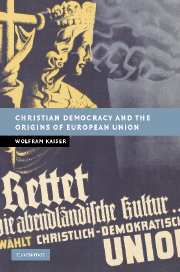Book contents
- Frontmatter
- Contents
- Acknowledgements
- Abbreviations
- Introduction
- 1 All paths to Rome? Transnational Catholicism in the nineteenth century
- 2 Under siege: Catholic parties in interwar Europe
- 3 After Versailles: left-Catholic cooperation
- 4 In the shadow of dictatorship: contacts in exile
- 5 Hegemony by default: Christian democracy in postwar Europe
- 6 Creating core Europe: the rise of the party network
- 7 Deepening integration: the supranational coalition embattled
- 8 Informal politics: from Rome to Maastricht
- Bibliography
- Index
- NEW STUDIES IN EUROPEAN HISTORY
2 - Under siege: Catholic parties in interwar Europe
Published online by Cambridge University Press: 14 July 2009
- Frontmatter
- Contents
- Acknowledgements
- Abbreviations
- Introduction
- 1 All paths to Rome? Transnational Catholicism in the nineteenth century
- 2 Under siege: Catholic parties in interwar Europe
- 3 After Versailles: left-Catholic cooperation
- 4 In the shadow of dictatorship: contacts in exile
- 5 Hegemony by default: Christian democracy in postwar Europe
- 6 Creating core Europe: the rise of the party network
- 7 Deepening integration: the supranational coalition embattled
- 8 Informal politics: from Rome to Maastricht
- Bibliography
- Index
- NEW STUDIES IN EUROPEAN HISTORY
Summary
World War I was indeed a useless massacre. Its end in 1918 initially brought exciting new opportunities for political Catholicism across Europe, however. New Catholic parties were created in Italy, Spain, France and the successor states of the Habsburg Empire. Existing Catholic parties successfully continued to integrate large sections of (practising) Catholics. Although with 37 per cent of the vote the Belgian Catholics only narrowly remained the strongest party in the first postwar elections, they continued to play a dominant role in government formation. While electoral support for the German Centre Party declined somewhat from 13.6 per cent in 1920 to 11.9 per cent in the last free elections in November 1932, it was the core political force in all parliamentary governments in the Weimar Republic until 1930, with nine of twenty chancellors until 1932 coming from its ranks. Catholics throughout Europe became more eager to participate in political life, not just through Catholic parties, but also through newly created youth organisations and the publication of a large number of periodicals. Some of these – such as the German Abendland and Hochland, the Belgian La Cité chrétienne, the French Politique and L'Aube – acquired excellent intellectual reputations and were read throughout Europe and also outside of Catholic circles. Even more importantly, Catholic politics became much less introspective in concentrating on the defence of Church rights and influence. It increasingly began to engage with general socio-economic and political issues of society as a whole, developing a new programmatic vitality.
- Type
- Chapter
- Information
- Christian Democracy and the Origins of European Union , pp. 42 - 71Publisher: Cambridge University PressPrint publication year: 2007
- 1
- Cited by



